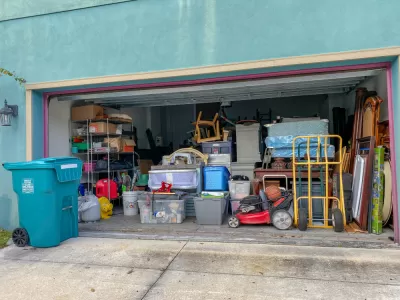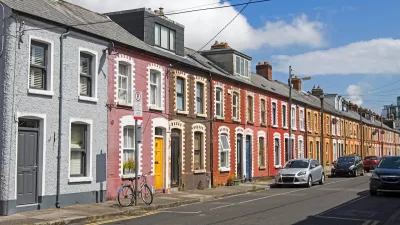With curbside parking available for free in front of most American homes, residents with private garages often choose to utilize the space for household storage. Putting a price on street parking could change that.

“The government constructs, maintains and distributes free car storage space along the curb in front of almost every house,” asserts Catie Gould, and because of this readily available parking space in single-family neighborhoods, many Americans park their cars on the street and use their garages for other purposes.
“A survey of detached homeowners in Sacramento, California, published in February, showed that when there isn’t space enough for both storing a car and household items, the cars are the items that end up moving elsewhere. The survey found that 37 percent of homeowners didn’t store a single car in their garage.” Surveys from other cities show similar results. A long-range UCLA study “found that 3 of 4 households had too much stuff in their garage to park a car.”
According to Gould, “When storing a car on the curb is free, a garage isn’t necessarily a garage: it’s a great big walk-in closet.” So, Gould asks, “When there is so much evidence that people don’t reliably use private parking spaces to store their cars, why does nearly every city still require them to be built?” Gould explains that these requirements can have a negative impact on housing affordability. “Mandates for off-street parking spaces raise housing costs and prevent housing from being built in the first place.”
Using an example from Vancouver, British Columbia, Gould argues that cities should price curb spaces to incentivize residents to park in their own garages or driveways and free up curbside space for public parking or other uses.
FULL STORY: One in Three Garages Has No Car in It

Manufactured Crisis: Losing the Nation’s Largest Source of Unsubsidized Affordable Housing
Manufactured housing communities have long been an affordable housing option for millions of people living in the U.S., but that affordability is disappearing rapidly. How did we get here?

Americans May Be Stuck — But Why?
Americans are moving a lot less than they once did, and that is a problem. While Yoni Applebaum, in his highly-publicized article Stuck, gets the reasons badly wrong, it's still important to ask: why are we moving so much less than before?

Using Old Oil and Gas Wells for Green Energy Storage
Penn State researchers have found that repurposing abandoned oil and gas wells for geothermal-assisted compressed-air energy storage can boost efficiency, reduce environmental risks, and support clean energy and job transitions.

San Antonio Remains Affordable as City Grows
The city’s active efforts to keep housing costs down through housing reforms and coordinated efforts among city agencies and developers have kept it one of the most affordable in the nation despite its rapid population growth.

What Forest Service Cuts Mean for Cities
U.S. Forest Service employees work on projects that have impacts far beyond remote, rural wilderness areas.

North Texas Transit Leaders Tout Benefits of TOD for Growing Region
At a summit focused on transit-oriented development, policymakers discussed how North Texas’ expanded light rail system can serve as a tool for economic growth.
Urban Design for Planners 1: Software Tools
This six-course series explores essential urban design concepts using open source software and equips planners with the tools they need to participate fully in the urban design process.
Planning for Universal Design
Learn the tools for implementing Universal Design in planning regulations.
Heyer Gruel & Associates PA
City of Moreno Valley
Institute for Housing and Urban Development Studies (IHS)
City of Grandview
Harvard GSD Executive Education
Salt Lake City
NYU Wagner Graduate School of Public Service
City of Cambridge, Maryland





























